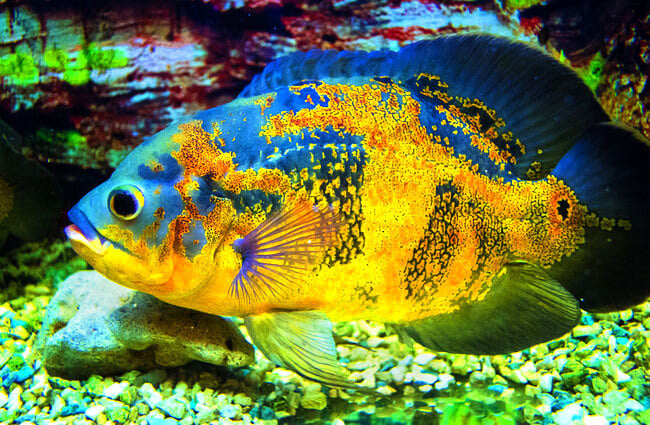The Oscar Fish, also known simply as the “Oscar,” is a species in the cichlid family. Some people also refer to this species as the Tiger Oscar, Marble Cichlid, or Velvet Cichlid. Though it hails from South America, you can find this fish in home aquariums virtually worldwide. Read on to learn about the Oscar Fish.
Description of the Oscar Fish
The appearance of this species varies based on where it lives. Animals in the wild have different colors and generally do not reach the same size as those in aquariums. In the wild, they generally have grey or dark brown scales with yellow and orange spots.
In home aquariums, breeders have developed a variety of colors. The primary coloration is similar to the wild fish, but with orange marbling across the body. Breeders have also established albino and all-black colorations as well.
Interesting Facts About the Oscar Fish
As popular pets, you can spot these fish in many home aquariums across the globe. Learn more about what makes them so unique, below.
- Outstanding Ocelli – Particularly in wild individuals, you will notice this fish has small round spots on its fins. These spots, known as “ocelli, or “eye spots,” look similar to eyes. Researchers believe that the eye spots help deter predators.
- Piranha Problems – Those ocelli come in handy with non-predators as well. In the Amazon River Basin, these fish coexist with piranhas. While the piranhas are not direct predators to the oscar, they do bite at the fish’s fins. Scientists believe that the ocelli reduce this behavior.
- Floundering Fins – While fin nipping doesn’t kill the fish, it does impact their overall survival ability. Those fish who suffer from the nibbling of piranhas often grow more slowly, and sometimes their fins become infected.
- Protective Parents – Like many cichlids, this species protects its young from predators. They keep the eggs clean, move the newly hatched young, and protect the young fry.
Habitat of the Oscar Fish
In the wild, this species lives primarily in freshwater habitats. It occupies mostly rivers and streams. They prefer clear, slow moving waters. Additionally, they primarily forage in streams with muddy or sandy bottoms.
In human care, people keep these fish in large aquariums. Their tanks must be substantially sized for the number of fish because they reach relatively large sizes.
Distribution of the Oscar Fish
This fish lives throughout portions of Central and South America. Its primary range is the Amazon River Basin, but you can find it in Peru, Brazil, Colombia, and Ecuador. Humans have also released this species outside of its native range. Invasive populations exist in Florida, Asia, and Australia.
Diet of the Oscar Fish
In the wild, these fish have omnivorous feeding habits, which means that they eat both plant and animal matter. Most of their diet consists of invertebrates and other small creatures. Some common prey items include insects, snails, clams, shrimp, and more.
They forage primarily by sifting through the sand and mud along the bottom of the river or stream they inhabit. When they find a potential meal, they use suction to capture the prey.
Oscar Fish and Human Interaction
Humans interact with this fish species quite frequently. This species is by far one of the most popular cichlid species in home aquariums. However, because they reach large sizes, people often release these fish into areas outside of their native range. This can sometimes damage the native ecosystems.
Domestication
Humans have not domesticated this fish in any way.
Does the Oscar Fish Make a Good Pet
Yes, this species makes a good pet. These fish are large and attractive looking. However, you should always purchase captive-bred pets. Wild-caught animals can spread disease to your other fish, and deplete native populations.
Oscar Fish Care
These fish grow quite large, and thus need plenty of space in their aquarium. Additionally, they establish territories, so you must provide plenty of space to prevent conflict between the fish. You can feed them commercially produced fish food for carnivorous fish, as well as worms, insects, and crayfish.
Behavior of the Oscar Fish
While they often live in close proximity to one another, these fish develop and defend their own personal territories, not allowing other fish to enter.
Individual fish spend their time patrolling their territories, and shifting through the mud or sand at the bottom in search of food. As breeding season approaches, pairs begin to establish.
Reproduction of the Oscar Fish
Oscars breed with only one partner per season. The pair establishes and defends their territory aggressively. They spend several days finding the perfect spot to spawn, and thoroughly clean the area. Females lay their eggs, usually on a flat surface, and the males fertilize them.
On average, a single female can produce about 1,600 eggs, depending on her age and size. It takes 2 or 3 days for the eggs to hatch. During this period, both parents guard and clean the eggs. The parents continue to protect the young after hatching. The fry remain with their parents until they reach between 8 and 12 months of age.













![Red Angus Closeup of a beautiful Red Angus cowPhoto by: U.S. Department of Agriculture [pubic domain]https://creativecommons.org/licenses/by/2.0/](https://animals.net/wp-content/uploads/2020/03/Red-Angus-4-238x178.jpg)


![Red Angus Closeup of a beautiful Red Angus cowPhoto by: U.S. Department of Agriculture [pubic domain]https://creativecommons.org/licenses/by/2.0/](https://animals.net/wp-content/uploads/2020/03/Red-Angus-4-100x75.jpg)

